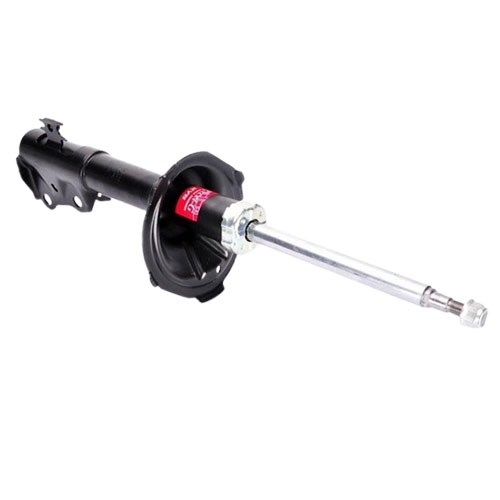-4%
Get Shock Absorber Toyota Probox/ Vitz/Platz Front 333368 KYB
Shock absorbers, also known as dampers, are essential components of a vehicle’s suspension system. Their primary function is to control the movement of the suspension and manage the impact and rebound of the vehicle’s springs. This control ensures a smooth and comfortable ride by reducing the oscillations and vibrations transmitted from the road surface to the chassis. Shock absorbers achieve this through the conversion of kinetic energy into heat energy, dissipating it through hydraulic fluid or gas.
Functions of Shock Absorbers
Shock absorbers serve several critical functions in a vehicle’s suspension system:
- Damping Oscillations: The primary function of shock absorbers is to dampen the oscillations of the vehicle’s springs. When the wheels encounter bumps or uneven surfaces, shock absorbers absorb the energy and ensure that the vehicle body remains stable and level.
- Improving Ride Comfort: By reducing the bouncing and vibrations caused by road imperfections, shock absorbers contribute to a smoother and more comfortable ride for passengers.
- Enhancing Vehicle Stability: Shock absorbers help maintain tire contact with the road surface, improving traction, handling, and stability during acceleration, braking, and cornering maneuvers.
- Controlling Body Roll: They mitigate excessive body roll during cornering, maintaining a balanced and predictable vehicle response.
- Protecting Suspension Components: Properly functioning shock absorbers reduce the wear and tear on other suspension components, such as springs, control arms, and bushings, thereby extending their lifespan.
Types of Shock Absorbers
There are several types of shock absorbers, each designed to meet specific performance requirements and vehicle applications:
- Twin-Tube Shock Absorbers: This is the most common type, featuring an inner tube (working cylinder) where the piston moves and an outer tube (reserve tube) that holds hydraulic fluid. Twin-tube shocks provide a good balance of comfort and performance for most passenger vehicles.
- Monotube Shock Absorbers: Monotube shocks have a single tube design with a piston and high-pressure gas (usually nitrogen) separated by a floating piston or dividing piston. They offer superior heat dissipation and are more responsive to changing road conditions, making them ideal for performance vehicles and off-road applications.
- Gas-Charged Shock Absorbers: Similar to twin-tube shocks but with a chamber of pressurized gas (nitrogen) above the hydraulic fluid. This design minimizes aeration and foaming of the hydraulic fluid, improving consistency and performance under heavy loads or during extended use.
- Adjustable Shock Absorbers: These shocks allow for adjustments in damping force or stiffness. Drivers can customize the ride quality and handling characteristics to suit different driving conditions or preferences, making them popular in performance vehicles and racing applications.
Signs of Worn or Failing Shock Absorbers
Recognizing the signs of worn or failing shock absorbers is crucial for vehicle safety and performance:
- Excessive Bouncing: If the vehicle continues to bounce excessively after encountering bumps or dips in the road, it indicates that the shock absorbers are no longer effectively damping the suspension movement.
- Poor Handling and Stability: Worn shock absorbers can lead to increased body roll, unstable steering, and reduced overall handling performance. The vehicle may feel less responsive and less controlled during maneuvers.
- Uneven Tire Wear: Shock absorbers that are not functioning correctly can cause uneven tire wear due to inconsistent contact between the tires and the road surface.
- Oil Leaks: Visible signs of oil leaks or dampness around the shock absorber housing indicate worn seals or internal damage, requiring immediate attention and possible replacement.
- Knocking or Rattling Noises: Unusual noises coming from the suspension area, such as knocking or rattling sounds, may indicate loose or worn shock absorbers.
Maintenance and Replacement
Maintaining and replacing shock absorbers is essential for ensuring optimal vehicle performance and safety:
- Regular Inspection: Periodically inspect shock absorbers for signs of leaks, physical damage, or excessive wear. Check for changes in ride quality, handling, or unusual noises.
- Timely Replacement: Replace shock absorbers according to the manufacturer’s recommended intervals or if signs of wear or failure are detected. Delaying replacement can lead to further damage to other suspension components and compromise vehicle safety.
- Quality Replacement Parts: Use high-quality shock absorbers that match the vehicle’s specifications and performance requirements. Quality parts ensure reliable performance and longevity.
- Professional Installation: If you are not experienced with suspension systems, have a professional mechanic install the new shock absorbers. Proper installation is crucial for safety and optimal performance.
Replacement Process
Replacing shock absorbers involves several steps:
- Lift and Secure the Vehicle: Use a jack to lift the vehicle and support it securely with jack stands. Remove the wheels to access the shock absorbers.
- Remove the Old Shock Absorbers: Unbolt the shock absorbers from the suspension mounts and carefully remove them. Take note of any mounting hardware or additional components that need to be transferred to the new shocks.
- Install the New Shock Absorbers: Position the new shock absorbers in place and secure them with the mounting hardware. Ensure that they are aligned correctly and torqued to the manufacturer’s specifications.
- Reassemble and Test: Reinstall the wheels, lower the vehicle, and perform a test drive to ensure that the new shock absorbers function properly. Check for any abnormal noises, vibrations, or handling issues.
Follow us on Facebook for more parts.


